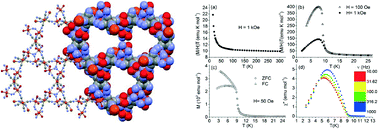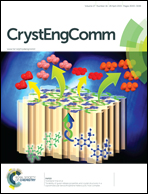The first 3D and trinuclear cyano-bridged FeIII–FeIII(CN)6 complexes: structure and magnetic characterizations†
Abstract
[Fe(SB)(H2O)]ClO4 and [NEt4]3[Fe(CN)6] react in methanol to give a cis cyano-bridged assembly, 3D [NEt4][Fe(5-ClL1)]2[Fe(CN)6] (5-ClL1H2 = N,N′-bis(5-chlorosalicylidenato)-2,2-dimethyl-1,3-diaminopropane), 1, and a trans cyano-bridged trinuclear complex, [NEt4][Fe(5-ClL2)(MeOH)]2[Fe(CN)6] (5-ClL2H2 = N,N′-bis(5-chlorosalicylidenato)-1,2-diaminopropane), 2, depending on the Schiff base used. Complexes 1 and 2 have been characterized by X-ray analyses and magnetic measurements. The four CN− in the equatorial plane of the [Fe(CN)6]3− moiety bridge four Fe ions each in the cis position, which results in a 3D neutral layered structure giving a [–Fe–NC–Fe–CN–Fe–] linkage for 1. The two CN− in the equatorial plane of the [Fe(CN)6]3− moiety bridge two Fe ions, in the trans position, which results in a hydrogen bonded 2D neutral layered structure for 2. Magnetic studies reveal that complex 1 exhibits weak intralayer ferromagnetic coupling, while complex 2 displays transition to a 3D ferromagnetic order between low-spin Fe(III) and high-spin Fe(III) through the cyanide bridges. Complex 2 further displays frequency-dependent alternating current magnetic susceptibility.


 Please wait while we load your content...
Please wait while we load your content...